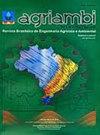灌溉深度和施氮量对甘蔗产量和工艺品质的影响
IF 1.4
4区 农林科学
Q3 AGRICULTURAL ENGINEERING
Revista Brasileira de Engenharia Agricola e Ambiental
Pub Date : 2020-07-01
DOI:10.1590/1807-1929/agriambi.v24n7p482-489
引用次数: 1
摘要
摘要本试验旨在评价不同灌溉深度和施氮量下2个甘蔗品种的茎产量、产糖量和工艺品质。该实验连续两年(2015年和2016年)在巴西伯南布哥州itamb本文章由计算机程序翻译,如有差异,请以英文原文为准。
Yield and technological quality of sugarcane under irrigation depths and nitrogen fertilization
ABSTRACT The objective of this study was to evaluate the stalk yield, sugar yield and technological quality of two varieties of sugarcane under different irrigation depths and nitrogen doses. The experiment was conducted in two consecutive years (2015 and 2016) at Olho D’Água Farm, in Itambé, Pernambuco, Brazil. The experimental design was randomized blocks in the split-split-strip-plot scheme, with four replicates. Treatments consisted of four irrigation depths (L1 = 12, L2 = 45, L3 = 100 and L4 = 125% of the crop evapotranspiration - ETc, plant cane) and (L1 = 10, L2 = 40, L3 = 100 and L4 = 125% ETc, ratoon cane), four doses of nitrogen (N1 = 0, N2 = 50, N3 = 100 and N4 = 200 kg ha-1 of N) and two varieties of sugarcane (RB92579 and RB002754). Sugarcane plants irrigated with the highest depths of 1,324.06 and 1,242.3 mm in the plant cane and ratoon cane cycles respectively produced 38.40 and 49.14 t of stalks ha-1 and 0.48 and 1.82 t of sugar ha-1 more, compared to those irrigated with the lowest depths of 124.06 and 99.4 mm. The highest stalk yield was obtained with the combination of 120.7 kg ha-1 of N and 1266.6 mm of irrigation depth. Sugarcane technological quality is positively correlated with the increase of the irrigation depth in the plant cane and ratoon cane cycles and negatively correlated with nitrogen.
求助全文
通过发布文献求助,成功后即可免费获取论文全文。
去求助
来源期刊

Revista Brasileira de Engenharia Agricola e Ambiental
Agricultural and Biological Sciences-Agronomy and Crop Science
CiteScore
2.70
自引率
16.70%
发文量
114
审稿时长
3-8 weeks
期刊介绍:
A Revista Brasileira de Engenharia Agrícola e Ambiental (Agriambi), periódico oficial da Asociación Latinoamericana y del Caribe de Ingeniería Agrícola (ALIA), é editada mensalmente, no formato eletrônico, pela Unidade Acadêmica de Engenharia Agrícola (UAEA) do Centro de Tecnologia e Recursos Naturais (CTRN) da Universidade Federal de Campina Grande (UFCG), destinando-se à divulgação de artigos científicos originais e inéditos, elaborados em Português, Inglês ou Espanhol. Com o auxílio de pareceres de Consultores, os artigos são aceitos ou não pela Equipe Editorial para publicação na Revista. A Agriambi aceita, também, a submissão de contribuições na modalidade de revisão de literatura.
 求助内容:
求助内容: 应助结果提醒方式:
应助结果提醒方式:


